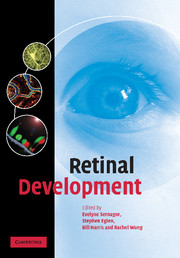Book contents
- Frontmatter
- Contents
- List of contributors
- Foreword
- Preface
- Acknowledgements
- 1 Introduction – from eye field to eyesight
- 2 Formation of the eye field
- 3 Retinal neurogenesis
- 4 Cell migration
- 5 Cell determination
- 6 Neurotransmitters and neurotrophins
- 7 Comparison of development of the primate fovea centralis with peripheral retina
- 8 Optic nerve formation
- 9 Glial cells in the developing retina
- 10 Retinal mosaics
- 11 Programmed cell death
- 12 Dendritic growth
- 13 Synaptogenesis and early neural activity
- 14 Emergence of light responses
- New perspectives
- Index
- Plate section
- References
14 - Emergence of light responses
Published online by Cambridge University Press: 22 August 2009
- Frontmatter
- Contents
- List of contributors
- Foreword
- Preface
- Acknowledgements
- 1 Introduction – from eye field to eyesight
- 2 Formation of the eye field
- 3 Retinal neurogenesis
- 4 Cell migration
- 5 Cell determination
- 6 Neurotransmitters and neurotrophins
- 7 Comparison of development of the primate fovea centralis with peripheral retina
- 8 Optic nerve formation
- 9 Glial cells in the developing retina
- 10 Retinal mosaics
- 11 Programmed cell death
- 12 Dendritic growth
- 13 Synaptogenesis and early neural activity
- 14 Emergence of light responses
- New perspectives
- Index
- Plate section
- References
Summary
Introduction
Although the newborn retina is highly active, with spontaneous waves propagating across the amacrine and the ganglion cell layers every few minutes (see Chapter 13), at that time it is not yet possible to elicit light responses in retinal ganglion cells (RGCs). This lack of responsiveness to light is due to the immaturity of the vertical synaptic pathway between photoreceptors and RGCs provided by bipolar cells (BCs), despite the fact that lateral connections in the inner retina are already well established (see Chapter 13). Moreover, rod and cone opsins are not yet functional at birth. In mouse for example, ultraviolet cone opsin does not appear until postnatal day (P)1, rod opsin until P5 and green cone opsin until P7 (Tarttelin et al., 2003). Hence, RGCs become visually responsive only shortly before eye opening (around P10 in rabbit; Masland, 1977; Dacheux and Miller, 1981a, b; P7 to P10 in cat; Tootle, 1993; P12 in mouse; Sekaran et al., 2005). Humans and other primates, on the other hand, are born with their eyes open and although primate vision is poor at birth a newborn human infant is capable of tracking visual stimuli (Teller, 1997).
This chapter reviews the earliest light responses that can be detected in the developing retina. New studies show that the newborn retina is actually not insensitive to light and this will be considered in the first part of the chapter.
- Type
- Chapter
- Information
- Retinal Development , pp. 288 - 304Publisher: Cambridge University PressPrint publication year: 2006
References
- 1
- Cited by



